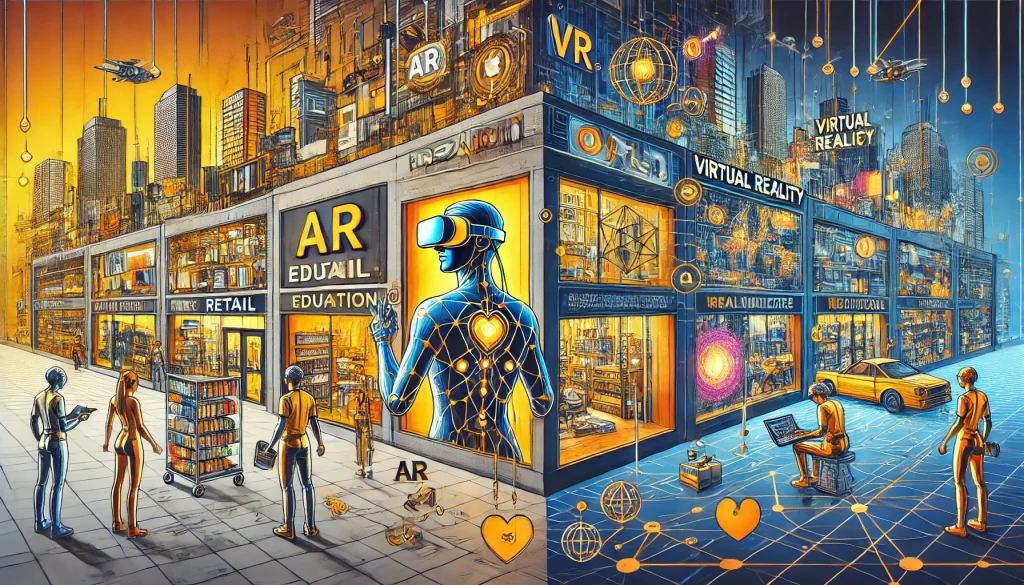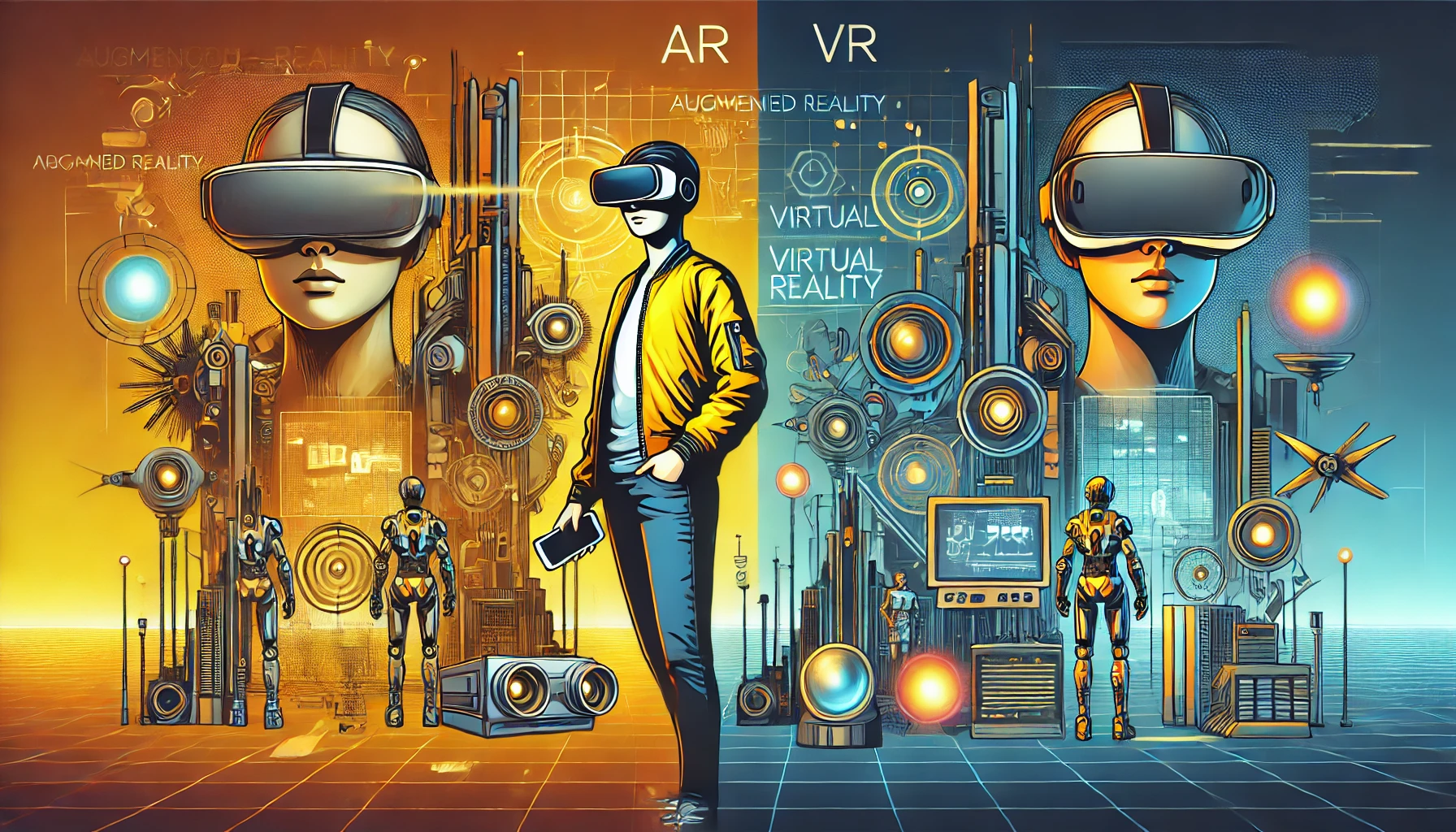Augmented reality (AR) and virtual reality (VR) are two groundbreaking technologies that are revolutionizing the way we experience and interact with digital content. From immersive gaming to transforming industries like healthcare and education, the potential of these technologies is boundless. In this review, we delve deep into the world of AR and VR, compare their functionalities, highlight their pros and cons, and provide an in-depth analysis of their usability and performance across various industries. By the end, you’ll have a clear understanding of which technology fits your needs.
Overview
Augmented reality (AR) and virtual reality (VR) both offer distinct ways of blending the real and digital worlds, but they do so in fundamentally different ways. While AR overlays digital elements onto the real world, enhancing the user’s perception of reality, VR completely immerses users in a simulated environment. Both technologies are transforming sectors like gaming, education, and training, each with its unique set of features.
Key Features:
- AR (Augmented Reality): Enhances the real-world environment by overlaying digital elements.
- VR (Virtual Reality): Fully immerses the user in a computer-generated, interactive environment.
- AR Applications: Used in industries like healthcare, education, retail, and navigation.
- VR Applications: Prominent in gaming, virtual tours, simulations, and training programs.
AR Pros and Cons
The technologies present different advantages and challenges depending on their applications. Let’s explore the strengths and weaknesses of both.
Pros
| Feature | Description |
|---|---|
| Enhanced Reality | AR blends digital and real worlds, providing users with an improved version of reality. |
| Accessible | AR can be accessed on smartphones, eliminating the need for expensive equipment like VR headsets. |
| Practical Use | AR is already used in various industries such as healthcare, navigation, and retail for practical purposes. |
| Interactive | The technology supports real-time interaction with the environment, making it more immersive. |
Cons
| Feature | Description |
|---|---|
| Limited Immersion | AR does not provide full immersion into digital environments, which can limit user experience in certain cases. |
| Distraction | Overlaid digital elements may disrupt focus or become distracting in certain contexts. |
| Hardware Limitations | AR’s functionality often depends on the hardware, like smartphones, which may limit its performance. |
| Privacy Concerns | Constant monitoring of real-world environments raises potential privacy issues. |
VR Pros and Cons
Pros
| Feature | Description |
|---|---|
| Full Immersion | VR offers a complete, immersive experience that transports users into an entirely different reality. |
| Realistic Simulations | VR is ideal for realistic training and simulations, such as in the fields of aviation and medicine. |
| Interactive and Engaging | The interactivity in VR environments enhances user engagement, especially in entertainment and learning. |
| High Customizability | Developers have full control over the VR environment, allowing for extensive customization. |
Cons
| Feature | Description |
|---|---|
| Expensive | Requires specialized equipment, like VR headsets, which can be costly for average users. |
| Physical Discomfort | Prolonged use of VR may cause motion sickness or discomfort for some users. |
| Learning Curve | Users might find VR interfaces and controls harder to master, leading to longer adaptation times. |
| Isolation | VR isolates users from the real world, which may not be suitable for all contexts. |
In-Depth Analysis of Augmented Reality vs. Virtual Reality
Introduction to In-Depth Analysis
Both AR and VR are transforming the way we interact with technology, but the experiences they offer are vastly different. In this section, we will explore how these technologies perform across various categories such as design, functionality, usability, and industry applications.
To better understand how augmented reality (AR) and virtual reality (VR) function, it’s crucial to analyze them across various categories such as design, functionality, usability, and their respective applications. Both technologies offer unique experiences and come with different requirements and outcomes. Below, we explore each category in more depth and compare how AR and VR differ in each area.
Design

The design approach for AR and VR is fundamentally different. AR focuses on enhancing the real world with digital elements, whereas VR creates an entirely new environment for the user. Here’s a comparison of their design philosophies:
| Category | Augmented Reality (AR) | Virtual Reality (VR) |
|---|---|---|
| Design | Enhances real-world environments with digital overlays, allowing interaction with real-world objects. | Fully immerses users in a simulated digital environment, isolating them from the real world. |
Functionality

When it comes to functionality, AR is accessible via everyday devices like smartphones, making it easy for users to incorporate into their daily lives. VR, however, requires dedicated hardware for full immersion. This category outlines how both technologies operate:
| Category | Augmented Reality (AR) | Virtual Reality (VR) |
|---|---|---|
| Functionality | Requires minimal equipment like smartphones or AR glasses; overlays information on real-world objects. | Requires specialized hardware such as VR headsets and controllers to create a fully immersive experience. |
Usability
Usability is a critical factor for both AR and VR. AR’s ease of use stems from its compatibility with familiar devices, while VR’s more complex setup can require more time to master but provides a highly engaging experience once learned. Let’s compare their ease of use:
| Category | Augmented Reality (AR) | Virtual Reality (VR) |
|---|---|---|
| Usability | Easy to use with devices like smartphones and tablets, making it more accessible for everyday applications. | More complex setup involving VR headsets; requires time to master controls but offers deeper immersion. |
Applications

Both AR and VR are used across a variety of industries, but the nature of their applications is quite different. AR is frequently applied in industries where real-world interaction is crucial, such as retail and healthcare, whereas VR is more suited for immersive experiences like gaming and training simulations.
| Category | Augmented Reality (AR) | Virtual Reality (VR) |
|---|---|---|
| Applications | Commonly used in retail, education, healthcare, and navigation for enhanced real-world interaction. | Popular in gaming, simulations, virtual training, and immersive experiences like virtual tourism. |
Hardware
The hardware requirements for AR are relatively minimal, utilizing devices such as smartphones, which makes it more affordable. VR, however, necessitates specialized equipment like headsets and controllers, making it a costlier investment.
| Category | Augmented Reality (AR) | Virtual Reality (VR) |
|---|---|---|
| Hardware | Utilizes devices already in use, such as smartphones, reducing costs. | Requires high-performance hardware, such as VR headsets and powerful computers, increasing costs. |
Immersion
The level of immersion provided by AR and VR is one of the most striking differences between the two. While AR offers partial immersion by overlaying digital content on the real world, VR delivers full immersion, transporting users to an entirely different digital environment.
| Category | Augmented Reality (AR) | Virtual Reality (VR) |
|---|---|---|
| Immersion | Partially immersive by adding digital elements to the real world. | Fully immersive, creating a complete virtual experience detached from reality. |
Augmented Reality vs. Virtual Reality Comparison
While AR and VR share similarities, their applications, design principles, and functionality differ significantly. Here’s a side-by-side comparison:
| Aspect | AR (Augmented Reality) | VR (Virtual Reality) |
|---|---|---|
| Immersion | Enhances reality by overlaying digital content | Fully immersive, replacing reality with a virtual world |
| Equipment | Requires smartphones, tablets, or specialized glasses | Requires VR headsets, controllers, and high-processing power |
| Applications | Retail, healthcare, navigation, and education | Gaming, virtual simulations, and training programs |
| Cost | More affordable and accessible | Expensive due to the need for specialized hardware |
| Learning Curve | Easy to pick up and use for general consumers | Higher learning curve due to complex controls |
Conclusion
In summary, both augmented reality and virtual reality have their own strengths and limitations. Augmented reality is more accessible and practical for everyday use, especially in sectors like retail, healthcare, and education. It enhances real-world experiences and can be easily accessed through devices we already own, like smartphones. Virtual reality, on the other hand, offers a more immersive experience but requires specialized equipment. It is ideal for industries that need high levels of interaction and engagement, such as gaming or simulations.
For those looking for practical, accessible technology with immediate real-world applications, AR is a great fit. However, if you want a fully immersive digital experience for gaming, training, or virtual tourism, VR is the technology to choose.
Augmented Reality vs. Virtual Reality Rating
For overall experience:
- AR: ★★★★☆ (4/5)
- VR: ★★★★☆ (4/5)
Both technologies score high marks for innovation and usability but offer different experiences suited to different needs.

